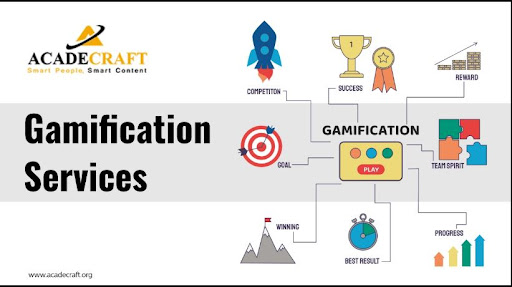WAYS TO USE GAMIFICATION SERVICES FOR YOUR BUSINESS
Gamification is a new mantra in the corridor of educational organizations. Many are confused about the game and gaming. They are not the same. The game means for fun and entertainment; on the contrary, Gamification stands for providing an instructional strategy that attempts to enhance engagement, participation, and motivation.
It is purely a way of rendering the best of learning things. Gamification uses game strategies like rules of playing, point-scoring, and embeds with competitive features applied to a website or online community.
If it puts in the learning perspective like training, Gamification helps simplify learning aspects to make it more engaging and immersive. Hence, Gamification Services are the most preferred option for the organization. If drill-downs a bit regarding Gamification, it helps to learn through competition and many challenges.
That means it effectively affects behavioral chance and makes sure for long-term engagement. A host of exciting things in Gamification like competition, challenge, rewards, and personalization, but these irresistible charms of Gamification spell the people and prompt them to come back often for more.
According to a survey global Gamification market size was estimated at USD 10.19 million in 2020 and is expected to attain USD 38.42 million by 2026 and grow at a compound annual growth rate of 25.10% within the forecast period of 2021-2026.
The surging smartphone and mobile device accelerate a comprehensive base for the Gamification market. If properly executed, it can significantly enhance the learning and training process to a new high and helps to power the cognitive process.
Gamification Plays a Key Role in Training
The corporate can use Gamification training in two ways - Gamification in the course indicates that it is a one-time event. The other is Gamification can embed in the curriculum.
Criteria for using Gamification in Enterprise Training
There are certain critical factors to consider before applying Gamification in training. They state below:
Mistaken of Considering Gamification is a Game
Gamification is not considered a video game, but it goes beyond that. It judiciously injects game mechanisms to introduce certain behavioral aspects. Gamers tend to change and influence their behavior when playing games, getting rewards, and doing other gaming activities. It improvises the players' thinking process, enabling them to make better decisions in real-life situations.
Developing Empathy
Empathy is no doubt a treasure trove in the corridor of the corporate world. It helps with management and collaboration that leads to understanding the other learner's perspective. In the same breath, Gamification does not only emphasize design but also focuses on empathy among the team players.
The primary premise of game-based learning is not focused on the over-competitive game but on igniting empathy and building an experience in the direction of developing masterly and maintaining autonomy in the workplace and, at the same time, establishing a healthy relationship among the team.
A good Gamification design always emphasizes that employees are the game's heroes and under no circumstance dwarfs the performance by comparing peer performance in cut-throat competitions.
Having Seamless Experience
The days are passé when copious and tedious text ruled the roost. In today's context, learners' patience wears thin. They need a kind of learning that is short and engaging. Gamification ideally cements those loopholes. The learning process of it is to divide the learning concepts into micro-nuggets.
Disruption and the abysmal attention span of the learner prompt trainers, publishers, and educators to devise a fascinating, interactive, and immersive learning, and all micro-learning shares the same principles. It can offer a short, memorable chunk of content that learners can pursue in their spare time.
The content is composed so that it does not take much time, minimizing the hours following it. In addition, it can be personalized to provide learning to learners in areas where they are struggling.
Jack Up Motivation
It is a proven fact that learners pat on motivation when job satisfaction is there, and it is much more than financial rewards. Simply put, it provides better motivation than extrinsic motivation. As already stated, Gamification casts the spell more on human behavior.
According to experts, 80% of Gamification would fail to achieve its objective due to its poor design. Care should take while implementing the enterprise training in mind and mindful of rules to enjoy relevant Gamification.
Changing Corporate Culture
Implementing Gamification in training has its special meaning in the sense that training is in line with organizational objectives. While playing, the employees can observe their performance and understand it objectively and fairly.
Hence, transparency is ensured, and it impacts the culture's change in the way it shows the performance and how to manage it Waiting to see their performance at the yearend review, the employee can view their performance in real-time. It has greatly benefitted the team to see their mistakes and subsequently remediate them. As a result, it benefits the organization significantly.
Contrast Over Traditional Learning and Gamification
Game-based learning has revolutionized the education system, and it designs in such a way that it involves a high level of customization, and learners can adopt self-paced learning and provides an abundance of time for practice and feedback. The process of learning involves both individuals and teams, and any issue faced by the learners can solve by the omnipresent instructor.
Confidence Regain in Handling Real-Life Situation
Gamification helps learners understand the real-life complexities and mistakes in the virtual world. Having trained in this process, they can negotiate with real-world problems better. The striking aspect, in this case, is that it helps the organization refrain from costly mistakes, thereby saving money and reputation.
Wrapping Up


Comments
Post a Comment